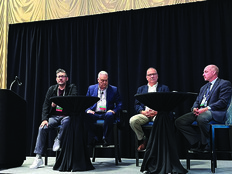2017 Budget Boosts IT Spending to $89.9 Billion, Expands U.S. Digital Service
President Barack Obama’s fiscal 2017 budget proposal — the last one of his presidency — contains $89.9 billion in federal IT spending, up 1.3 percent from fiscal 2016. Although modest in terms of the spending increase, the administration says its IT spending is growing at a slower rate than in the past, and that more agencies are using provisioned services like the cloud.
The budget also includes an expansion of the U.S. Digital Service, the select fix-it team of private sector innovators, entrepreneurs and engineers who joined the federal government to improve and streamline the delivery of government services.
Capturing Cost Savings
The budget proposal allocates $51.33 billion for civilian IT spending and $38.55 billion for defense-related IT spending, up 1.1 percent and 1.5 percent, respectively, from fiscal 2016, according to Federal Times.
In a briefing with reporters on Tuesday, federal CIO Tony Scott said that from fiscal 2001 through 2009, annual growth in IT spending was about 7.1 percent; but from fiscal 2009 through 2017, IT spending has grown at just 1.8 percent per year. Scott said that was due to greater efficiency in how funds have been spent as well as improved project management and governance.
Since 2012, the federal government has saved close to $4 billion as a result of the administration’s IT reform efforts, Scott said, including initiatives such as PortfolioStat, the federal Cloud Computing Strategy, commodity IT consolidation, migration to shared services, increased use of modern development practices, and data center consolidation and optimization efforts.
The federal government now spends around 8.2 percent of its IT budget on provisioned services such as cloud, which the administration says is “on par with leading private sector companies.”
Scott echoed a statistic that the budget discusses, noting that agile development — an incremental, fast-paced style of software development that can reduce the risk of failure — is now used for half of new federal software projects, compared with just 35 percent in 2012. He also noted that IT hardware spending has declined 25 percent from 2010 levels.
Scott, a former CIO of cloud and virtualization software firm VMware, said he has noticed that in both the private sector and in government, “the more we adopt modern technologies, it tends to flatten out the spending. If done right, it can fund new development in new infrastructure that you would want to put in.” Scott noted that the toughest challenge in federal IT spending is to get funding for new infrastructure and applications.
Increase in Cybersecurity Funding
Part of the fiscal 2017 budget includes $19 billion set aside for cybersecurity, a 35 percent increase from fiscal 2016. Scott said that 19 out of 24 CFO Act federal agencies are receiving increases in cybersecurity funding.
An element of that increase is a $3.1 billion revolving fund to retire and modernize legacy federal IT systems, because older systems tend to have greater vulnerabilities. The administration’s cybersecurity plan will push agencies to evaluate their vulnerable IT infrastructure. Scott said that “as agencies adopt these more modern technologies and more cost-effective ways of doing things,” they could pay back into the fund to support more modernizations.
The budget also highlights that in 2015, as part of the “cybersecurity sprint” following the hacks at the Office of Personnel Management, federal civilian agencies took action to patch critical vulnerabilities, identify high-value assets, tightly limit the number of privileged users with access to authorized systems, and dramatically accelerate the use of Personal Identity Verification cards or alternative forms of strong authentication for accessing networks and systems.
PIV cards are a measure the federal government has used to authenticate access to federal assets and networks, and Scott noted that federal civilian agencies have nearly doubled their use of PIV card for all users, from 42 percent to 81 percent.
Boosting Digital Services
The U.S. Digital Service was formed to fix HealthCare.gov in 2014, and has since expanded its work to other agencies, including the Departments of Homeland Security and Veterans Affairs. To facilitate requests for short-term support, USDS created a new rapid response team in 2015, which helped restore service for the State Department’s Consolidated Consular Database after an outage led to a two-week suspension of visa issuances worldwide.
In 2016, USDS is partnering with the IRS to strengthen electronic authentication procedures, laying the groundwork for unified and secure taxpayer access to all IRS digital services.
The fiscal 2017 budget funds the development of USDS teams at 25 agencies, with a goal of hiring and placing 500 USDS members within the government by January 2017.
In addition, USDS has worked with OPM to “create a term-appointment hiring authority for Digital Services Experts to more quickly get talent into government service,” which will continue this year and next.
Scott said he is “very excited” about the USDS expansion and that USDS members can help agencies evaluate how to get IT savings, improve security and adopt shared services as part of the evaluation of IT infrastructure in the cybersecurity plan.









